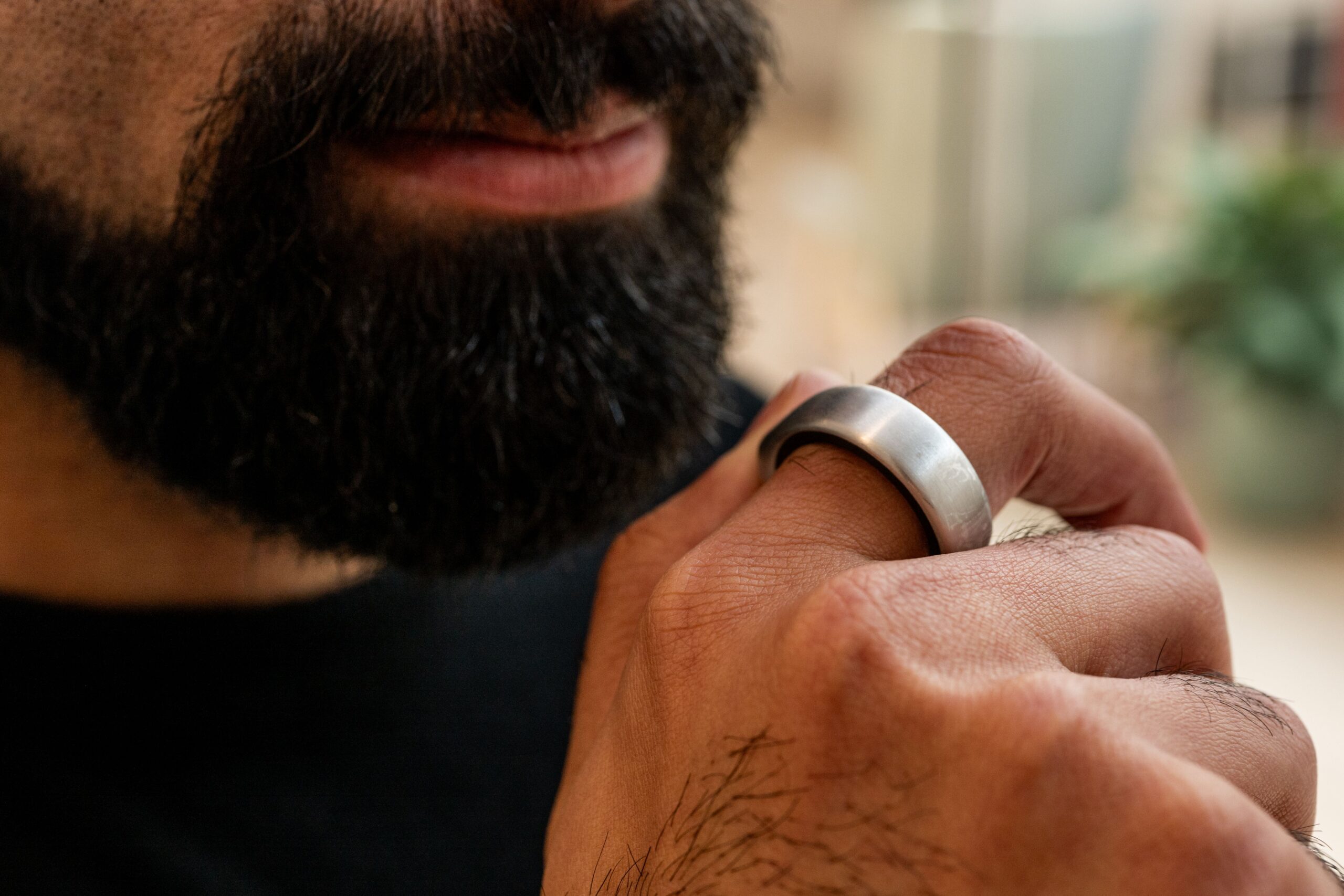Everyone has an inner monologue. When you’re commuting on the train, riding a bike, or in the shower, chances are you’re thinking about the day ahead, tasks you need to do, or maybe just mulling over a conversation you had the night before. Much of this stays in our brains, soon to be forgotten or pushed away when the train comes to the station. But what if you could have it all subtly recorded in one place, ready for you to digest later on?
That’s what a new company called Sandbar envisions for Stream Ring, an AI-powered smart ring. The company emerged out of stealth today after two years of development, led by cofounders Mina Fahmi and Kirak Hong. Both previously worked at CTRL-Labs and later at Meta when Mark Zuckerberg’s company acquired the neural interface startup. It has raised $13 million in venture funding.
A “Mouse for Voice”
.png)
Photograph: Julian Chokkattu
The hardware is Stream Ring, a smart ring you wear on your index finger. Raise your hand and talk into the ring, and you can even whisper into it in crowded areas if you don’t want others to hear. It doesn’t save any audio of your interactions with the ring; instead, much like many of the AI-powered wearables in the market right now, it transcribes your words into text, which you can access in the Stream app.
“We think of this as the mouse for voice because it solves a lot of the challenges of a voice interaction at once,” Fahmi tells me in a nondescript office space in Manhattan. “We mostly imagine it phone away, earbuds in—this allows you to interact immediately with no wake word.”
There’s a capacitive sensor on the flat edge of the ring, and a tap-and-hold lets you record your thoughts without being interrupted by an AI assistant. If the assistant responds to you, a simple tap on the sensor will cut it off. The hardware will be waterproof at launch, so you won’t have to worry about using it in the rain or on sweaty days.
The Stream also doubles as a media controller, meaning you can tap it once to play or pause music, double-tap for the next track, or swipe for volume control. If, for some reason, Sandbar goes under and its AI backend goes offline, at least you’re left with a very expensive media controller, rather than hardware that quickly turns into electronic waste. At present, there are no health-tracking features like those on most smart rings today.
.png)
Photograph: Julian Chokkattu
The Stream Ring is available for preorder today in silver ($249) or gold ($299). You can get a ring-sizing kit to determine your size. Each purchase includes three months of Stream Pro, a subscription service that offers unlimited notes and chats, and access to the company’s early features. After the trial period, you’ll have to pay $10 per month. There is a free tier, though you’ll be limited in what features you can access and how many interactions you can make. Sandbar expects to ship the ring in the summer of 2026. You’ll need the ring to access the app, though Fahmi says that could change in the future.
The idea is you can talk to the Stream Ring about anything. Ask it what ingredients are needed for a Kerala chicken curry recipe, and it’ll give you the answers based on results from the web. You can then ask it to put all of those ingredients into a shopping list, so you can have it ready when you enter a grocery store. Now imagine you’re at the grocery store—ask the ring to remind you of what you need, and ask it to cross items off as you place produce into your basket. You’ll feel some haptics from the ring as acknowledgment; no screen needed.
Fahmi describes Stream as a tool that sits between a notes app and an AI chatbot. “Stream is what we call a self-extension that’s meant to feel like you’re talking to yourself to help you build ideas,” he says. “Maybe you’re curious about something, or you’re planning a meeting you’re going into, or you’re thinking through the narrative of something you want to write—you can just kind of riff back and forth. At any time, if you want to save something into a note, you can ask Stream to put it into a note, and it’ll organize those.”
Stream of Consciousness
.png)
Photograph: Julian Chokkattu
Stream is powered by several popular large language models, opting for whatever is best suited for the task at hand. There’s a mix of on-device processing on the ring, some processing on your connected smartphone, and some in the cloud.
When the AI assistant talks back to you, it’ll sound eerily like your own voice—just like your inner monologue. During setup, you’ll be asked to say a few phrases, and the app will process that data and generate a voice that sounds very similar to your own. (This is powered by generative AI models from ElevenLabs.) I tried this out, and it indeed sounded like me, just slightly off—a bit deeper than my already-deep voice—which Fahmi says is intentional. There will be other voices you can choose if you don’t want to hear a weird version of yourself.
You can use it to simply ask a question as you would run a Google Search. (During my demo, the ring didn’t have real-time internet access; Fahmi assures me it will have it when the product ships.) In usage so far by a close-knit group with demo rings, Fahmi says there’s about 20 percent note-creation, 20 percent single queries, and 60 percent conversation. That means most of the people testing the ring right now are having more back-and-forth conversations with the Stream Ring, whether that’s a discussion around the optimal plants to place in the backyard or prepping for a job interview you’re heading to.

Photograph: Julian Chokkattu
Fahmi says the ring has “all-day” battery life, and there’s a nifty little charger you can place the ring on to top it up, though that’s a far shorter window than most smart rings that promise multiple days or even a week of run time. That’s likely because you’re interacting with the Stream Ring far more frequently, and many other smart rings just passively track your health. There’ll be a desktop interface to access your notes, the ability to share notes with other people, and create time-based reminders.
“One way that we view this is that it’s the lowest friction interface to thought,” Fahmi says. “You can begin to do a lot of interesting things with that, like a running log of things you’ve eaten, or workouts you’re planning. For some people, rather than tracking their heart rate, they want to track their thoughts, and this is a particularly powerful tool for that.”
Thought Ring

Photograph: Julian Chokkattu
It’s a complicated time for AI chatbots. There’s an uptick in people claiming AI psychosis after conversations with ChatGPT. More recently, the company behind the always-listening Friend AI pendant saw its subway ads defaced by New Yorkers. Fahmi doesn’t want you to think of the Stream Ring as a friend, but as an extension of yourself. The Stream Ring isn’t an always-listening wearable—you decide when you want to talk to it. “You have to be in control; you can’t just ambiently record everything,” he says.
To get around the AI fear, as Fahmi calls it—worries that AI is replacing jobs or may erode creativity—is by placing people at the center of control so the machine acts as an extension of your will. People “push on us, they challenge us, they have their own lives; that’s the magic of people. Computers should not be that.”
What if you decide to share deeply personal thoughts with Stream and ask it for advice? Fahmi says the company invests heavily in evaluations to simulate synthetic user interactions to modify how Stream responds to certain conversations. The goal is to make Stream’s “character” curious, compassionate, and concise with no defining identity; a tool that can answer questions and is emotionally intelligent but ultimately with no will, opinions, or intent of its own. However, the responses will be personalized based on what you’ve shared with the ring. (You’ll be able to inspect and control what is shared.)
“We want you to have autonomy over it,” he says. “We also want to ensure that we’re building something wise and good. This is something a lot of the industry is grappling with and trying to thread a needle through. We’re on that journey together, and I hope that our approach of it not being a companion or an assistant leads us to an outcome that feels really good.”




